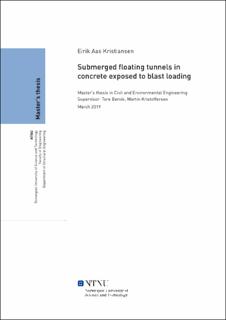| dc.contributor.advisor | Børvik, Tore | |
| dc.contributor.advisor | Kristoffersen, Martin | |
| dc.contributor.author | Kristiansen, Eirik Aas | |
| dc.date.accessioned | 2019-09-23T14:00:11Z | |
| dc.date.issued | 2019 | |
| dc.identifier | no.ntnu:inspera:35217218:22961623 | |
| dc.identifier.uri | http://hdl.handle.net/11250/2618291 | |
| dc.description.abstract | Denne oppgaven presenterer arbeidet utført med å undersøke hvor godt numeriske verktøy er i stand til å simulere oppførselen til betongrør utsatt for en indre eksplosjonslast.
En neddykket rørbru har blitt foreslått som en mulig løsning for kryssing av Sognefjorden i forbindelse med prosjektet ferjefri E39. En potensiell fare ved en rørbru er en eksplosjon inne i tunnellen. Gitt at full-skala testing er svært upraktisk, gir numeriske analyser sammen med skalerte eksperimenter et godt alternativ.
En-aksielle trykktester og spaltestrekkforsøk ble utført for å bestemme betongens egenskaper, samt å gi et grunnlag for validering av K\&C betongmodellen. DIC ble brukt til å måle deformasjon av prøvestykkene, og ga lovende resultater frem til begynnende sprekkdannelse, hvoretter analysen ikke klarte å fange betongens oppførsel. K\&C betongmodellen er enkel å bruke da eneste nødvendendige inndata er betongens trykkfasthet. Videre justering av materialparametre virker lovende for å forbedre ytelsen.
Det planlagte eksperimentelle arbeidet på betongrør måtte endres underveis, og tidligere utførte forsøk med indre eksplosjoner fra C-4 ladninger ble brukt som sammenligningsgrunnlag for numeriske simuleringer. Lagrange-analyser med ConWep-modellen underestimerte trykkbølgen, men overestimerte likvel skaden på rørene. Resultaten var dog kvalitativt tilfredstillende og lovende for videre studier. | |
| dc.description.abstract | A submerged floating tunnel(SFT) in has been proposed as a possible solution in crossing the Sognefjord as a part of the ferry-free E39 project. A potential safety hazard is an explosions inside the tunnel. Given that full-scale testing is highly impractical, numerical analyses coupled with scaled experiments is a good alternative.
Uniaxial compression and tensile splitting tests were conducted to determine the concrete properties and serve as a validation basis for the Karagozian and Case (K\&C) material model. Digital image correlation was used to measure the specimen deformation, and showed promise in the pre-cracking regime, but failed to capture the behaviour after fracture. Subsequent numerical simulations of the material tests were done, and gave decent results. The K\&C model is simple to use through its parameter generation only requiring input of compression strength, and tuning of the other parameters seems promising in improving its performance
The planned experimental testing on concrete pipes had to be adjusted during the thesis, and previously conducted test with internal blasts loads from C-4 charges was utilised for numerical comparison. Lagrangian simulations with the ConWep model underestimated the blast magnitude, but still overestimated the pipe damage. Nevertheless the results were qualitatively satisfying, and showed promise for further studies. | |
| dc.language | eng | |
| dc.publisher | NTNU | |
| dc.title | Submerged floating tunnels in concrete exposed to blast loading | |
| dc.type | Master thesis | |
